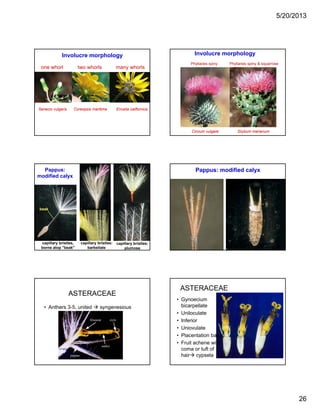This document provides information on the classification and characteristics of several plant families, including Myrtaceae, Lythraceae, Fabaceae, Euphorbiaceae, Moraceae, Malvaceae, Anacardiaceae, and Meliaceae. It describes key morphological features such as leaf arrangement, flower structure, fruit type, and economic uses. Many examples of plants from each family are given. The families discussed belong to the orders Myrtales, Fabales, Malpighiales, Rosales, Malvales, Sapindales, and are examples of the large group of flowering plants called eudicots.
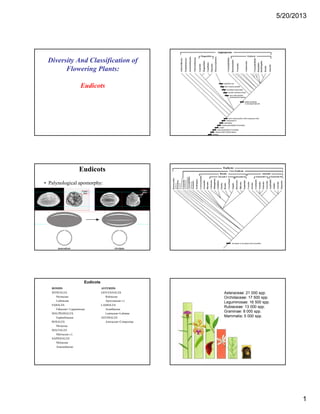
![5/20/2013
2
Diversity And Classification of
Flowering Plants:
Eudicots: Rosids
ROSIDS
• Very large, monophyletic group of
Eudicots
• Linked by no clear non-molecularLinked by no clear non molecular
apomorphies
• Ovules bitegmic (2 integuments) &
crassinucellate [contrast with Asterids]
Myrtaceae - Myrtle family
(myrtus, Gr. name for myrtle). 120 genera / 3850 species
• trees and shrubs
• with glandular-punctate or pellucid leaves
• Usually epiperigynous flowers with
numerous stamens.numerous stamens.
• Papery or flaky bark
• Aromatic – terpenes, spicy resin
• Leaves pellucid-dotted
Ca 4-5 Co 4-5 A ∞ G (2-5), inferior
[rarelyhalf-inferior or superior], with
hypanthium.
MYRTACEAE
• Psidium guajava “guava”
• Eucalyptus “well” “conceal”, referring
to operculum covering stamens in budto operculum covering stamens in bud
• Syzygium samarangense “makopa”
• Syzygium cumini “duhat” = Eugenia
jambolana
• Callistemon](https://image.slidesharecdn.com/eudicotssummer2013compatibilitymode-130520042426-phpapp02/85/Eudicots-summer2013-compatibility-mode-2-320.jpg)
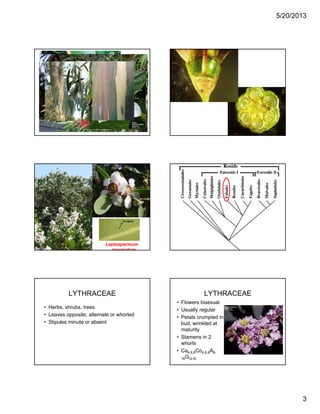



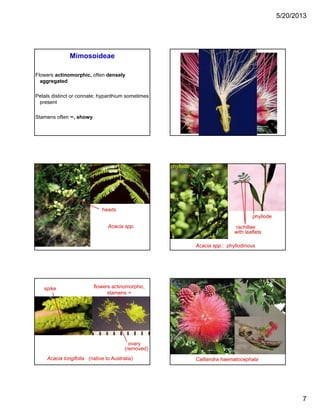









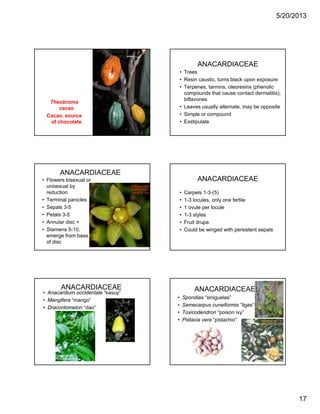



![5/20/2013
21
Lamiaceae (=Labiatae) - Mint family
(Lamium, gullet, after the shape of the corolla tube or old Latin name
used by Pliny). 251 genera / 6,700 species.
often aromatic with ethereal oils
with usually 4-sided stems, opposite [or whorled] leaves
verticillaster or thyrse inflorescence [flowers solitary and axillary
in some], and zygomorphic [rarely actinomorphic],
usually bilabiate flowers
deeply 4-lobed ovary (by formation of "false septa") and
gynobasic style
Ca (5) Co (5) A 4 G (2), superior, hypanthium absent.
Mentha, mint;
Ocimum, basil;
Rosmarinus rosemary;Rosmarinus, rosemary;
Salvia, sage;
Thymus, thyme
Leaves opposite; stems 4-
sided](https://image.slidesharecdn.com/eudicotssummer2013compatibilitymode-130520042426-phpapp02/85/Eudicots-summer2013-compatibility-mode-21-320.jpg)

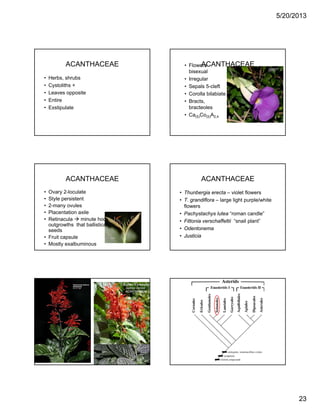
![5/20/2013
24
Asteraceae (Compositae)
Characteristics:
Inflorescence a head (capitulum):
subtended by inflorescence bracts: involucral
bracts or phyllaries, collectively termed the
involucre.
Calyx modified as pappus.
Stamens syngenesious.
K pappus C 5 A (5) G(2), inferior, 1 basal
ovule
Fruit an achene.
Asteraceae (=Compositae) -
Sunflower family
(after Aster, meaning star). 1,528 genera / 22,750 species.
a head (capitulum) subtended by an involucre of phyllaries,
--bilabiate, disk, or ray/ligulate, (heads of many taxa a mixture of
t l di k fl d i h l fl )central disk flowers and peripheral ray flowers),
with the calyx, termed a pappus, modified as scales, awns, or
capillary bristles (or absent),
the androecium syngenesious,
inferior ovary with a single, basal ovule,
the fruit a multiple of achenes.
Asteraceae (=Compositae) -
Sunflower family
(after Aster, meaning star). 1,528 genera / 22,750 species.
Ca 0-∞ (pappus)
Co (5) [(4)] or (3) in some ray flowers
A (5) [(4)]
G (2), inferior, hypanthium absent.
Asteraceae: floral variation
Three types of flowers:
1) Bilabiate: zygomorphic (bilateral) with 2
lips
2) Ray (ligulate): zygomorphic (bilateral)
with 1 lobe
3) Disk: actinomorphic (radial), usu. 5-lobed
Three types of heads:
1) discoid, with only disk flowers;
2) radiate, with central (bisexual or male) disk
flowers and peripheral (female or sterile) ray
flowers;flowers;
3) ligulate, with all ray flowers (typically with
5-toothed corolla apices);](https://image.slidesharecdn.com/eudicotssummer2013compatibilitymode-130520042426-phpapp02/85/Eudicots-summer2013-compatibility-mode-24-320.jpg)

